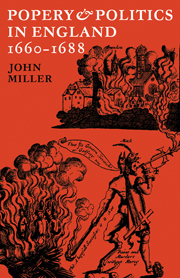Book contents
- Frontmatter
- Contents
- Preface
- Abbreviations
- Note on spellings and dates
- Introduction
- 1 The Catholic laity
- 2 England and Rome: the Catholic clergy
- 3 The penal laws and their enforcement
- 4 The development of the anti-Catholic tradition
- 5 The Restoration settlement and after
- 6 The French alliance and ‘Catholicity’
- 7 York and Danby
- 8 The Popish Plot and the Exclusion Crisis
- 9 The Tory reaction
- 10 James II and the Church of England Men
- 11 James II and the Dissenters
- 12 James II and Rome
- 13 The missionary effort under James II
- 14 The opposition to James II
- Appendices
- Select Bibliography
- Index
11 - James II and the Dissenters
Published online by Cambridge University Press: 07 October 2011
- Frontmatter
- Contents
- Preface
- Abbreviations
- Note on spellings and dates
- Introduction
- 1 The Catholic laity
- 2 England and Rome: the Catholic clergy
- 3 The penal laws and their enforcement
- 4 The development of the anti-Catholic tradition
- 5 The Restoration settlement and after
- 6 The French alliance and ‘Catholicity’
- 7 York and Danby
- 8 The Popish Plot and the Exclusion Crisis
- 9 The Tory reaction
- 10 James II and the Church of England Men
- 11 James II and the Dissenters
- 12 James II and Rome
- 13 The missionary effort under James II
- 14 The opposition to James II
- Appendices
- Select Bibliography
- Index
Summary
The failure of the policy of closeting marked the end of James's efforts to persuade the members of his Tory parliament to agree to the removal of the penal laws affecting Catholics. Although both Houses had proved loyal and compliant on most issues, they had made it clear in both sessions that they would not allow the toleration of Papists. After all the Tories' over-effusive protestations of loyalty and obedience during the earlier 1680s, their obstinacy on this point seemed to James like a slap in the face. Much of his later vindictiveness against the church, the universities and the Seven Bishops can be explained by his bitter sense of betrayal. The Declaration of Indulgence was not motivated solely by pique, of course. It had been apparent for some time that if James could not persuade his Anglican parliament to repeal the penal laws, he might try to get a Dissenting parliament that would do so, whatever he had thought of Dissenters in the past. If he wished to maintain the slightest pretence of legality, this parliament could contain no Catholics, as they were excluded by the 1678 Test Act. James considered dispensing with this act but his legal advisers told him firmly that such an action would be indefensible in law.
- Type
- Chapter
- Information
- Popery and Politics in England 1660–1688 , pp. 214 - 228Publisher: Cambridge University PressPrint publication year: 1973



